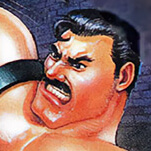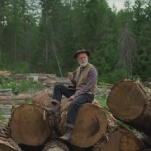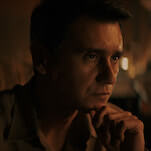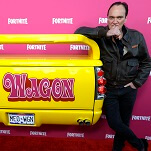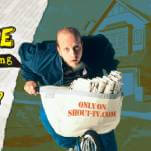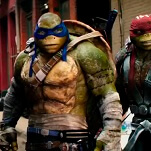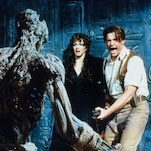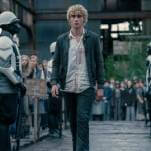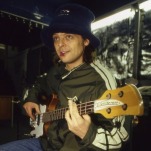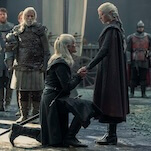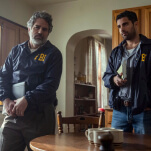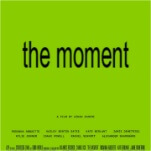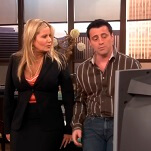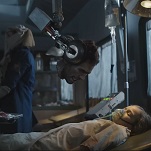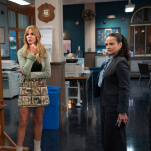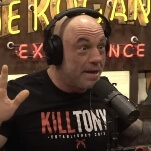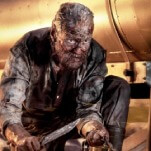Albert Maysles
With his brother David, Albert Maysles helped revolutionize both the documentary and film in general. Through the innovative use of portable cameras and sound equipment, which they helped design, they found a way to take their cameras to the streets, creating the naturalistic cinema-verité style. Working apart from his brother, Albert Maysles collaborated with D.A. Pennebaker and others in following the Kennedy/ Humphrey Wisconsin primary with the 1960 film Primary and collaborated with Jean-Luc Godard for his segment of the anthology film Six In Paris. But he remains best known for his work with David, who died in 1987. Together, they followed The Beatles' first visit to America (with What's Happening!: The Beatles In The U.S.A.) and examined such elusive characters as Marlon Brando, Muhammad Ali, Christo, and Truman Capote. Their most widely remembered films remain Salesman, a look at the soul-crushing life of Bible salesmen; Grey Gardens, a controversial study of a mother-daughter team of New England eccentrics related to Jacqueline Kennedy; and Gimme Shelter a chronicle of the '69 Rolling Stones tour of America that culminated in a free concert at the Altamont Speedway near San Francisco. Staged as one of several responses to Woodstock, Altamont has taken on almost mythic qualities: As the day progressed, a hostile environment developed among musicians, fans, and the security team, a group of Hell's Angels who partook liberally of alcohol and other substances despite their duties. As The Rolling Stones played "Under My Thumb," the Angels killed Meredith Hunter, a black concert attendee who had apparently been taunting them with a gun. In the singularly harrowing Gimme Shelter now being reissued in theaters and later on video, the Maysles Brothers captured the event on camera. Albert Maysles recently spoke to The Onion A.V. Club about the film and his career.
The Onion: Whose idea was it to cover the '69 Rolling Stones tour?
Albert Maysles: My brother and myself.
O: Why The Rolling Stones and why then?
AM: Well, we didn't know the Stones that well, the music or them. We'd never met them. But a very good friend of mine, the cinematographer Haskell Wexler, had been talking to them about a film. And I guess that didn't work out. He called us in San Francisco and said they were going to be in New York at the Plaza Hotel the next day, and that we might want to make a film with them. So we met them, and it just so happened that the next evening they had a concert in Baltimore. So we rushed off to Baltimore, and we thought they were terrific, of course. And we had a hunch, and that's all we could go on, that it would be more than a concert film. We didn't want to make a concert film; that wouldn't be enough. So, a few days later, we spent a couple of days filming them at Madison Square Garden and got really excited. Then we went to Muscle Shoals and Altamont, and after that we made a brief trip to England, and then did the filming of them watching the playback.
O: One of the most striking things about the film is how the mood of Altamont feels like a disaster in the making even before the bands play. Did you get that sense at the time, or is it something only seen in retrospect?
AM: I didn't get it, but Keith [Richards] is such a perceptive person: As we were approaching Altamont in the middle of the night, walking across the field we came across a fence and began to pull down the fence so we could climb over it. That's where he came up with the expression, "The first act of violence." And it happened later on.
O: It seems like a strange film to market, particularly as a re-release, because it's such a harrowing thing to watch.
AM: Somehow, I can't explain it, but maybe above all Gimme Shelter is a film you have to see over and over and over again. You can never get enough of it. Which is something of an irony, because you think, well… Suppose you saw an earthquake, for example. You see a little bit of it on television and you don't want to see any more. But here, there's too much going on. Every time you see this film, I think you see something you missed before. For example, the killing scene is kind of like that film Blow-Up. With Blow-Up, it's just a simple thing, a man in a bush. Here, you've got to wonder, when you see this scene, what's going on in the minds of each of the people who are around the killing. It must have occurred to many people, and it certainly occurred to me. Could anyone have stopped it? You can't see enough of this frightful, awful experience in one sitting. When the film was over, I wasn't sure—none of us were—that we'd gotten the murder. Finally, I hit upon it and just ran it over and over, slowly, frame by frame.


